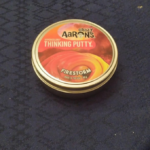The Best Fermented Drink for Your Kids
Our family’s eating habits aren’t too strange. I mean, sure, we do buy oatmeal in 50 pound bags from the bulk food store. We have accidentally raised corn smut and then decided we might as well eat it. And there was that time that our family all mutually agreed to cook a fat grub and split it four ways, in honor of one of my kids’ heroes, Bear Grylls. (Afterwards, we all mutually agreed we would not succeed as survivalists.) However, we also consume large quantities of things normal for a family of our stage in life – peanut butter, store-brand chips, deli meat.
But one thing our family has been doing for several years is growing living organisms on the kitchen counter. Ok, so maybe that’s not too strange. But we’ve actually been doing it deliberately. These are kefir grains.
Kefir grains are a living culture of bacteria and yeast – not too different from the cultures that make yogurt and kombucha. Placed in a container of milk for a day or two, kefir grains turn the milk into a thick, creamy, tart drink. A similar fermentation process turns barley, hops, or grapes into other stronger beverages, but the bacteria unique to kefir produces a different end product – one suitable for the whole family. Milk kefir has been around for generations – it’s a traditional Eastern European drink reputed to possess magical healing powers. (Indeed, some of those Eastern Europeans lived remarkably long lives.) Not a natural food guru myself, I don’t subscribe to the magic theory, but it does seem to have some health benefits, many similar to yogurt: along with the protein and minerals of milk, the probiotics (“good bacteria”) it contains are healthy for your digestive system, and easier on sensitive stomachs than milk.
These little kefir grains, though not magical, are quite hardy – which is good for an overly busy family. One night on the counter is usually sufficient to turn milk into kefir. The longer you let it sit, the more fermentation will take place, and the more sour will be the result. If we’re too busy to strain the grains, give them new milk, and concoct something out of the kefir, we slip it in the refrigerator, where it simply “hibernates” until we take it out again. Flexible creatures, these bacteria.
In our household, we have found a number of uses for kefir. Most often, we mix it with various kinds of fruit (bananas, raisins, grapes, etc) and enough sugar to make it acceptable to young palates, then blend it to form a tasty smoothie drink that we guzzle for breakfast. Occasionally we’ll throw in something like cinnamon or even shredded coconut to add variety. My wife has also tried substituting kefir for yogurt or milk in various recipes – from pancakes to muffins – with excellent results. Perhaps our favorite experiment was using “overripe” kefir in scratch-made cornbread. The result was a moist, rich cobbler with a bottom layer that tasted almost like custard. Quite a treat.
Kefir grains will live on indefinitely if continually fed (the Turkish families passed theirs on from one generation to the next). So, we will continue to grow living things in the kitchen for the foreseeable future… and enjoy fermented drinks for breakfast.
More from Tim Carr
- Virginia’s Native Allspice

- Wet and Wicked Weather in Western Virginia – Part 3

- Virginia’s Earth-shaking Events

- Roanoke – the Star City Game

- Saving the Planet, one Semi-Immortal Toyota at a time

- Chic(k) Lifestyle – Part 1
- Books to Read Aloud – Caddie Woodlawn

- 5 Random Items We No Longer Want To Do Without





